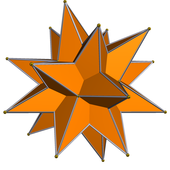Pseudo-deltoidal_icositetrahedron
The pseudo-deltoidal icositetrahedron is a convex polyhedron with 24 congruent kites as its faces. It is the dual of the elongated square gyrobicupola, also known as the pseudorhombicuboctahedron.
| Pseudo-deltoidal icositetrahedron | |
|---|---|
 (see 3D model) | |
| Type | Johnson dual, pseudo-uniform dual |
| Faces | 24, congruent |
| Face polygon |  Kite with: 1 obtuse angle 3 equal acute angles |
| Edges | 24 short + 24 long = 48 |
| Vertices | 8 of degree 3 18 of degree 4 26 in all |
| Vertex configurations | 4.4.4 (for 8 vertices) 4.4.4.4 (for 2+8+8 vertices) |
| Symmetry group | D4d = D4v, [2+,24], (2*4), order 4×4 |
| Rotation group | D4, [2,4]+, (224), order 2×4 |
| Dihedral angle | same value for short & long edges: |
| Properties | convex, regular vertices[1] |
| Net |  (click to enlarge) |
| Dual polyhedron |  |

As the pseudorhombicuboctahedron is tightly related to the rhombicuboctahedron, but has a twist along an equatorial belt of faces (and edges), the pseudo-deltoidal icositetrahedron is tightly related to the deltoidal icositetrahedron, but has a twist along an equator of (vertices and) edges.













